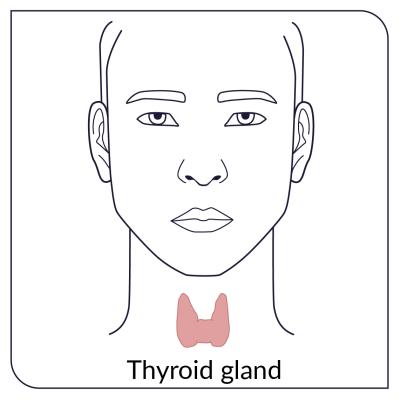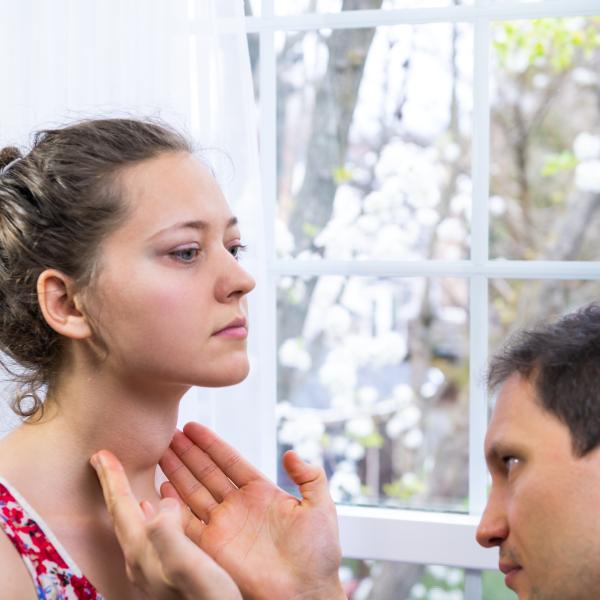What is Graves’ eye disease?
Graves’ eye disease happens when swelling around the eyes makes them bulge out. It’s caused by Graves’ disease, and it’s also called GED, Graves’ ophthalmopathy, or thyroid eye disease (TED).
Graves’ eye disease is often mild and may go away on its own. It doesn’t usually cause vision loss, but it may cause double vision and other symptoms. Treatments can help with these symptoms.

What is Graves’ disease?
Graves’ disease is an autoimmune disease. It happens when your immune system attacks your thyroid (a small gland in the front of your neck). This leads to hyperthyroidism — when your body makes too much thyroid hormone.
Graves’ disease can cause lots of serious health problems, including eye disease.
What are the symptoms of Graves’ eye disease?
The main symptom of Graves’ eye disease is bulging eyes (sometimes called proptosis). Other symptoms include:
- Dry, gritty, red, or irritated eyes
- Puffy eyelids
- Eyelids that pull back more than usual or don’t close all the way
- Double vision
- Sensitivity to light
- Eye pain or pressure
- Trouble moving your eyes when you look around
Graves’ eye disease usually affects both eyes, but you may only notice symptoms in 1 eye.
Symptoms usually last 1 to 2 years and often go away on their own. In rare cases, swelling around the eyes can press on the optic nerve (the nerve that connects the eye to the brain) and cause vision loss.

Am I at risk for Graves’ eye disease?
If you have Graves’ disease, you’re at risk for Graves’ eye disease. About 1 in 3 people with Graves’ disease develop some of these eye problems.
Smoking increases the risk for eye problems in people with Graves’ disease. If you smoke, make a plan to quit. You can call 1-800-QUIT-NOW (1-800-784-8669) for free support — or check out the resources on Smokefree.gov.
Graves’ disease is much more common in women and usually develops before age 40. You’re at higher risk if you have a family history of Graves’ disease — or if you have another autoimmune disease, like rheumatoid arthritis.
What causes Graves’ eye disease?
Sometimes Graves’ disease makes the immune system attack the muscles and other tissues around the eyes. This causes swelling behind the eye sockets, which makes the eyes bulge out.
Researchers aren’t sure what causes Graves’ disease. They think people with certain genes may be more likely to get it. Viruses or something else in the environment may act as a “trigger” that makes the disease develop in people who have these genes.
Graves’ disease isn’t contagious — you can’t get it from or give it to other people.
How will my eye doctor check for Graves’ eye disease?
Your eye doctor can check for Graves’ eye disease by doing a physical eye exam. During the exam, your doctor will take a close look at your eyes and eyelids.
If your eye doctor thinks you may have Graves’ disease, you’ll need blood tests to check if your thyroid is working correctly.
What’s the treatment for Graves’ eye disease?
If you have Graves’ disease, you’ll need treatment for your thyroid problems. Sometimes thyroid treatments help with Graves’ eye disease — but people often need separate treatments for their eye problems.
-

Over-the-counter eye drops. The most common treatment for dry or irritated eyes is a type of eye drops called artificial tears. You can get these without a prescription. There are also over-the-counter gels and ointments that may help your eyes feel better.
-

Prescription medicines. If you have a lot of swelling behind your eyes, your doctor may prescribe steroids (like prednisone) or other medicines (like rituximab) to help reduce swelling. Your doctor may also recommend a new medicine just for Graves’ eye disease called Tepezza (teprotumumab).
-

Quitting smoking. Smoking makes Graves’ eye disease worse — so quitting smoking is the most important lifestyle change you can make if you have this disease. If you smoke, make a plan to quit.
-

Other lifestyle changes. You can take steps to ease some common symptoms of Graves’ eye disease.
- If your eyes are sensitive to light, try using over-the-counter eye drops and wearing sunglasses when you go outside
- If you have puffy eyelids, try raising the head of your bed so your head is higher than your body while you sleep
- If your eyelids don’t close all the way, try taping them shut at night to prevent dry eye
-

Eyeglasses. If you have double vision, special prescription lenses (called a prism prescription) can help fix double vision and help you see more clearly.
-

Surgery. If Graves’ eye disease affects your vision, your doctor may recommend a surgery called orbital decompression. This surgery makes the eye socket bigger to ease pressure on the optic nerve and help the eye move back to the correct position. If your eyelids are pulling back too much, doctors may also recommend eyelid surgery to return your eyelids to a more normal position.
-

Radiation. In some cases, doctors may treat Graves’ eye disease with radiation. This treatment helps reduce swelling in the muscles and tissues around the eyes.
